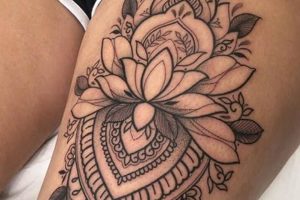Small, delicate designs, meaningful symbols, and intricate patterns are among the popular choices for permanent body art on the hands. Examples include floral motifs, minimalist lines, geometric shapes, or text-based designs like initials or short quotes. The placement can range from the fingers, knuckles, and palm to the back of the hand, each offering a unique canvas for self-expression.
Choosing to decorate this highly visible area allows for constant personal expression and can serve as a powerful statement of individuality. Historically, hand adornment has signified status, beliefs, or group affiliation across various cultures. Today, it continues to be a powerful form of self-expression, often reflecting personal experiences, values, or aesthetic preferences. This placement requires careful consideration due to its visibility and the potential impact on professional life.
Factors influencing design choices include pain tolerance, lifestyle, and long-term aesthetic considerations. Practical aspects like skin type, sun exposure, and potential fading should also be taken into account. Exploring different artistic styles, consulting with experienced tattoo artists, and carefully planning the design are essential steps in the process.
Tips for Hand Tattoos
Careful planning is crucial due to the visibility and permanence of hand tattoos. These tips offer guidance for making informed decisions.
Tip 1: Consider Professional Implications: Hand tattoos can be subject to workplace dress codes. Evaluate potential career impacts before committing to a design.
Tip 2: Research Artists Thoroughly: Seek artists specializing in fine linework and intricate details, given the limited space and complex contours of the hand.
Tip 3: Prioritize Aftercare: Hands are constantly exposed to the elements and frequent washing. Diligent aftercare is essential for proper healing and color retention.
Tip 4: Choose Meaningful Designs: Given their prominent placement, select designs with personal significance that will resonate over time.
Tip 5: Factor in Pain Tolerance: The skin on the hands is thin and sensitive. Be prepared for a more intense tattooing experience compared to other body parts.
Tip 6: Think About Long-Term Aesthetics: Hand tattoos are prone to fading due to sun exposure and frequent hand washing. Consider designs that will age gracefully.
Tip 7: Start Small: If unsure, begin with a small, discreet design. This allows for adjustment to the experience and aesthetics before committing to larger pieces.
Following these tips helps ensure a positive and fulfilling experience, resulting in a beautiful and meaningful piece of body art.
By carefully considering these factors, individuals can make informed choices that align with their personal style and long-term goals.
1. Placement
Placement is a paramount consideration for hand tattoos, significantly influencing the design’s aesthetic impact, practicality, and social perception. Careful selection of location enhances the interplay between the tattoo and the natural contours of the hand.
- Fingers:
Finger tattoos offer a canvas for small, delicate designs, often featuring minimalist symbols, initials, or bands. These placements are highly visible, making a subtle yet distinct statement. Practical considerations include potential wear and tear due to frequent hand use.
- Knuckles:
Knuckle tattoos, historically associated with specific subcultures, now encompass diverse styles, from bold lettering to intricate patterns. Due to the limited space, designs are typically compact and symbolic. Visibility and potential social interpretations should be factored into design choices.
- Side of Hand:
The side of the hand offers a larger canvas for more elaborate designs, allowing for flowing lines and greater detail. This placement can be easily concealed or displayed, providing flexibility in professional settings. Its less prone to wear and tear compared to finger or palm tattoos.
- Back of Hand:
The back of the hand presents a prominent display area suitable for larger, more intricate designs. Considered a bold choice due to its high visibility, this placement allows for artistic expression with greater detail and complexity. Sun exposure and potential fading are key factors to consider.
Ultimately, the chosen placement significantly contributes to the overall aesthetic of a hand tattoo. Careful consideration of visibility, practicality, and personal style ensures a harmonious integration of the design with the individual’s hand and overall image.
2. Size and Style
Size and style are integral components of hand tattoo design, profoundly impacting the aesthetic outcome and reflecting individual preferences. The delicate anatomy of the hand necessitates careful consideration of scale and artistic approach. A smaller hand may be overwhelmed by large, bold designs, while intricate details might be lost in excessively small tattoos. Style selection, ranging from minimalist linework to elaborate ornamental designs, further shapes the overall impression. A delicate floral motif evokes a sense of femininity and grace, whereas a bold geometric pattern projects a more contemporary and assertive aesthetic. The interplay between size and style creates a visual narrative, aligning the tattoo with the wearer’s personality and desired aesthetic.
Practical considerations also influence size and style choices. Fine line tattoos, popular for their intricate detail, require meticulous application and may be more prone to fading over time. Larger, bolder designs, while visually impactful, necessitate greater commitment due to their permanence and potential impact on professional life. Factors such as skin tone and lifestyle further inform decision-making. Individuals with darker skin tones may opt for bolder designs to ensure visibility, while those with active lifestyles might prioritize smaller, simpler tattoos that are less susceptible to wear and tear. Real-life examples demonstrate this interplay: a musician might choose a small, symbolic musical note on their finger, while an artist might prefer a sprawling, abstract design across the back of their hand.
Understanding the relationship between size, style, and the individual’s hand anatomy allows for informed design choices that harmonize aesthetics and practicality. Careful consideration of these elements ensures a timeless and meaningful piece of body art, reflecting personal expression while complementing the unique canvas of the hand. Successfully navigating these considerations ultimately empowers individuals to make choices that align with both their aesthetic vision and their lifestyle.
3. Symbolism
Symbolism imbues hand tattoos with profound meaning, transforming them from mere aesthetics into powerful personal statements. Careful selection of symbols allows individuals to express their values, beliefs, experiences, and aspirations in a deeply personal and visible way. The hand’s prominent placement further amplifies the chosen symbolism, making it a constant reminder of the individual’s narrative.
- Cultural and Spiritual Symbols:
Symbols drawn from various cultures and spiritual traditions offer a rich tapestry of meaning. Hamsa hands, representing protection and good fortune, or lotus flowers, symbolizing purity and rebirth, are common choices. Incorporating such symbols allows individuals to connect with their heritage or express their spiritual beliefs. For example, a woman might choose a Celtic knot to represent her Irish ancestry or a mandala to symbolize balance and harmony.
- Nature-Inspired Symbolism:
Elements from the natural world, such as flowers, animals, and celestial bodies, carry inherent symbolic weight. Roses symbolize love and passion, while butterflies represent transformation and resilience. A woman might choose a serpent to represent healing and rebirth or a wolf to symbolize loyalty and strength. These symbols often resonate deeply with individuals, reflecting their connection to nature and its inherent symbolism.
- Personal and Experiential Symbols:
Objects, dates, or initials representing significant life events or personal values add a unique layer of meaning to hand tattoos. A woman might choose to tattoo the coordinates of a meaningful place, the date of a loved one’s birth, or a symbol representing a personal triumph. These deeply personal symbols serve as permanent reminders of cherished memories and significant experiences.
- Abstract and Geometric Symbolism:
Abstract shapes and geometric patterns can convey complex concepts and emotions. A simple triangle might represent strength and stability, while an intricate geometric design can symbolize interconnectedness and the universe’s intricate patterns. These designs offer a visually striking and deeply symbolic form of expression.
By carefully considering the symbolic resonance of their chosen design, women can transform their hand tattoos into powerful expressions of self. The combination of placement, artistry, and profound symbolism elevates the hand tattoo beyond mere decoration, creating a lasting and meaningful piece of personal art that tells a unique story.
4. Pain Management
Pain management is a crucial aspect of the hand tattooing process, particularly for women who may have lower pain thresholds on this sensitive area. The hands possess a high concentration of nerve endings, making the procedure potentially more uncomfortable than tattoos on other body parts. Understanding and addressing pain effectively contributes significantly to a positive tattooing experience. Several strategies can minimize discomfort, allowing individuals to focus on the artistic process rather than the physical sensation. Effective pain management enables clients to remain still and relaxed, which is essential for the artist’s precision and the overall quality of the tattoo. Failing to address pain adequately can lead to premature termination of the session, resulting in an incomplete or compromised design. For instance, a woman considering an intricate floral design on the back of her hand might explore topical anesthetic creams to numb the area before and during the procedure, thus enabling her to endure the longer session required for detailed work. Another individual might employ mindfulness techniques, such as deep breathing exercises, to manage discomfort during a smaller tattoo on the finger.
Various pain management techniques cater to individual preferences and pain tolerance levels. Topical anesthetic creams, applied prior to the procedure, numb the skin’s surface, reducing discomfort during the tattooing process. Over-the-counter pain relievers, such as ibuprofen, can help manage inflammation and general discomfort, but should be used cautiously and in consultation with a healthcare professional. Numbing sprays, while less common, can provide temporary relief during the procedure. Beyond pharmacological interventions, non-pharmacological methods offer alternative approaches. Deep breathing exercises and meditation can promote relaxation and reduce anxiety, indirectly managing pain perception. Distraction techniques, such as listening to music or engaging in conversation with the artist, can also shift focus away from the physical sensation. Choosing an experienced and reputable tattoo artist proficient in pain management strategies further contributes to a comfortable and positive experience.
Effective pain management is not merely about comfort; it’s integral to achieving the desired artistic outcome. By minimizing discomfort and enabling clients to remain relaxed throughout the procedure, artists can execute intricate designs with precision and maintain consistent line quality. This results in a more aesthetically pleasing and technically sound tattoo. Furthermore, addressing pain concerns fosters a positive and empowering experience for individuals, especially those apprehensive about the procedure. Successfully managing pain transforms the tattooing process from a potentially daunting experience into a comfortable and fulfilling act of self-expression.
5. Aftercare
Diligent aftercare is paramount for hand tattoos due to their unique placement and the hand’s constant interaction with the environment. Proper aftercare significantly influences healing, color retention, and the long-term aesthetic of the tattoo. Hands are frequently washed, exposed to sunlight, and subject to friction, making them more susceptible to infection and fading. Neglecting aftercare can lead to complications such as infection, excessive scabbing, ink loss, and blurred lines. Conversely, meticulous adherence to aftercare protocols promotes optimal healing, preserving the vibrancy and clarity of the design. A woman with a delicate floral tattoo on her hand might experience premature fading and compromised detail if aftercare instructions, such as avoiding prolonged sun exposure and applying unscented moisturizer, are not followed. However, if the same individual adheres diligently to these guidelines, the tattoo’s intricate details and vibrant colors will remain intact for an extended period.
Specific aftercare practices tailored to hand tattoos are essential for successful healing. Keeping the tattoo clean and moisturized is crucial, but over-washing can dry out the skin and disrupt the healing process. Using a gentle, unscented soap and lukewarm water, followed by application of a fragrance-free, tattoo-specific moisturizer, creates an optimal healing environment. Protecting the tattoo from sun exposure is particularly critical for hand tattoos. Prolonged sun exposure can fade ink and damage the skin. Consistent application of a high-SPF sunscreen, even after the tattoo has fully healed, helps preserve the vibrancy of the colors and protects the skin’s integrity. Avoiding activities that could irritate or damage the healing tattoo, such as swimming in chlorinated water or engaging in activities that cause excessive friction, minimizes the risk of complications. For example, a woman with a new hand tattoo might wear gloves while gardening to protect the area from dirt and potential injury.
Understanding the critical role of aftercare in preserving the aesthetic and longevity of hand tattoos is fundamental. The hand’s constant exposure to external elements necessitates meticulous attention to hygiene, sun protection, and overall care. Consistent and diligent aftercare practices ensure that the artistry and symbolism of the tattoo remain vibrant and meaningful for years to come. Neglecting these crucial steps can compromise the tattoo’s appearance and increase the risk of complications. Therefore, prioritizing aftercare is an integral part of the decision-making process for anyone considering a hand tattoo, ultimately contributing to a successful and fulfilling experience. This understanding empowers individuals to protect their investment in body art and enjoy a beautifully healed, lasting piece of self-expression.
Frequently Asked Questions
Addressing common inquiries regarding hand tattoos provides clarity and facilitates informed decision-making. These responses offer practical insights and address potential concerns.
Question 1: How much do hand tattoos typically cost?
Pricing varies depending on size, complexity, artist experience, and geographic location. Obtaining quotes from multiple reputable artists is recommended.
Question 2: How long do hand tattoos take to heal?
Healing time typically ranges from two to four weeks, influenced by individual healing rates, aftercare diligence, and design intricacies.
Question 3: Are hand tattoos more painful than tattoos on other body parts?
Due to the hand’s thin skin and numerous nerve endings, the tattooing process on this area can be more sensitive. Various pain management techniques are available.
Question 4: Do hand tattoos fade faster than tattoos elsewhere?
Frequent hand washing and sun exposure can accelerate fading. Diligent aftercare, including regular sunscreen application, helps maintain vibrancy.
Question 5: What are the career implications of having hand tattoos?
Visibility makes hand tattoos subject to workplace dress codes. Considering potential career impacts before committing to a design is prudent.
Question 6: Can hand tattoos be covered up with makeup?
Specialized, high-coverage makeup designed for concealing tattoos can provide temporary camouflage, though complete concealment may be challenging depending on the design’s size and color saturation.
Careful consideration of these frequently asked questions aids informed decision-making. Consulting with experienced tattoo artists and conducting thorough research further empowers individuals to make choices aligned with their aesthetic preferences, lifestyle, and long-term goals.
Further exploration of specific design styles and artistic considerations enhances preparedness for the tattooing process.
Conclusion
Permanent body art on the hands presents a unique opportunity for self-expression. Placement, size, style, symbolism, pain management, and aftercare are critical considerations. Understanding these elements allows for informed decisions that balance aesthetic desires with practical implications. From delicate finger tattoos to intricate designs adorning the back of the hand, careful planning ensures a meaningful and aesthetically pleasing outcome.
Ultimately, the decision to acquire a hand tattoo requires thoughtful reflection on personal style, lifestyle, and long-term goals. Consultation with experienced artists and thorough research empower individuals to make choices that resonate with their individuality and stand the test of time. The hand, a canvas of constant visibility, offers a powerful platform for expressing one’s narrative through the art of permanent ink.







